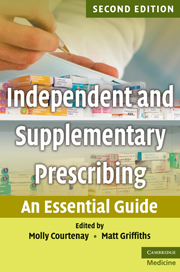Book contents
- Frontmatter
- Contents
- List of contributors
- Foreword to the second edition
- Preface to the second edition
- 1 Non-medical prescribing: an overview
- 2 Non-medical prescribing in a multidisciplinary team context
- 3 Consultation skills and decision making
- 4 Legal aspects of independent and supplementary prescribing
- 5 Ethical issues in independent and supplementary prescribing
- 6 Psychology and sociology of prescribing
- 7 Applied pharmacology
- 8 Monitoring skills
- 9 Promoting concordance in prescribing interactions
- 10 Evidence-based prescribing
- 11 Extended/supplementary prescribing: a public health perspective
- 12 Calculation skills
- 13 Prescribing in practice: how it works
- 14 Minimising the risk of prescribing error
- Index
- References
6 - Psychology and sociology of prescribing
Published online by Cambridge University Press: 10 January 2011
- Frontmatter
- Contents
- List of contributors
- Foreword to the second edition
- Preface to the second edition
- 1 Non-medical prescribing: an overview
- 2 Non-medical prescribing in a multidisciplinary team context
- 3 Consultation skills and decision making
- 4 Legal aspects of independent and supplementary prescribing
- 5 Ethical issues in independent and supplementary prescribing
- 6 Psychology and sociology of prescribing
- 7 Applied pharmacology
- 8 Monitoring skills
- 9 Promoting concordance in prescribing interactions
- 10 Evidence-based prescribing
- 11 Extended/supplementary prescribing: a public health perspective
- 12 Calculation skills
- 13 Prescribing in practice: how it works
- 14 Minimising the risk of prescribing error
- Index
- References
Summary
Why do doctors and other health professionals prescribe medicines? Why do patients want to take medicines? The simple answers to these questions can all be framed in terms of a biomedical model of the patient presenting with an illness and the prescriber trying to provide the means to help the patient get better. But this is only a partial truth, and really, prescribing is a more complex social interaction. Prescribing can be a means to a variety of ends. Unless we understand this, and understand why prescribers and patients behave as they do, we cannot understand prescribing. What is termed ‘irrational prescribing’ can often be explained, and by this understanding, we can work towards helping both prescribers and patients make the best use of medicines.
This chapter concerns itself with the multiplicity of non-biomedical reasons why patients may or may not receive a prescription. These lie partly in the psychology of the interaction between the individual prescriber and patient, but partly in the societies or cultures, professional, ethnic, local or even national, within which each operates; these two are so interwoven that they are best considered side by side.
In this chapter, we will talk a lot about doctor behaviour. This is because almost all of the research so far is about how doctors, rather than other professions, behave in relation to prescribing.
- Type
- Chapter
- Information
- Independent and Supplementary PrescribingAn Essential Guide, pp. 53 - 64Publisher: Cambridge University PressPrint publication year: 2010



